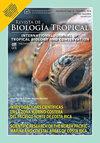美洲大陆的美洲虎保护:受保护的景观和人类影响的生物群落的作用
IF 0.6
4区 生物学
Q4 BIOLOGY
引用次数: 0
摘要
简介:在世界范围内,不断扩大的人类活动继续对包括美洲豹在内的许多大型物种构成威胁。随着这些活动的继续,了解人类改造景观将如何影响家庭范围的大小至关重要。目的:评估受保护和未受保护的土地对其范围内家庭范围大小的重要性。方法:我们使用了117只美洲豹的家域数据,这些美洲豹属于几个栖息地保护类别和人类生物群落类型。我们使用广义线性混合模型来测试家庭范围和与保护类别和人类生物群落的空间重叠。结果:大多数栖息地位于捷豹保护区(62%),其次是保护区(21%)、原住民土地(10%)和捷豹运动走廊(3%),其中76%的捷豹生活在前三种保护类型中的一种内。然而,在保护区之外,牧场、农田、神学院土地和其他人类生物群落也很重要(24%的个体)。牧场、农田和神学院的美洲虎拥有最大的栖息地。结论:尽管保护性土地占主导地位,但受人类影响的土地似乎在满足美洲豹的空间需求方面发挥了相当大的作用。本文章由计算机程序翻译,如有差异,请以英文原文为准。
Jaguar conservation in the American continent: the role of protected landscape and human-impacted biomes
Introduction: Worldwide, expanding human activities continue to be a threat to many large-bodied species, including jaguars. As these activities continue, it is critical to understand how home range sizes will be impacted by human-modified landscapes. Objective: To evaluate the importance of protected and unprotected land on home-range size across their range. Methods: We used home range data from 117 jaguars in several habitat protection categories and human biome types. We used a Generalized Linear Mixed Model to test home range and spatial overlap with conservation categories and human biomes. Results: Most home-ranges were in Jaguar Conservation Units (62 %), followed by Protected Areas (21 %), Indigenous People's Lands (10 %) and Jaguar Movement Corridors (3 %), where 76 % of the jaguars lived inside one the first three conservation types. However, outside of conserved land, Rangeland, Cropland, Seminatural land and other human biomes were also important (24 % of the individuals). Jaguars in Rangeland, Cropland and Seminatural land had the largest home ranges. Conclusions: Although conservation land was dominant, human-impacted lands appear to play a considerable role in satisfying the spatial requirements of jaguars.
求助全文
通过发布文献求助,成功后即可免费获取论文全文。
去求助
来源期刊

Revista De Biologia Tropical
生物-生物学
CiteScore
1.80
自引率
0.00%
发文量
23
审稿时长
4-8 weeks
期刊介绍:
The Revista de Biología Tropical / International Journal of Tropical Biology and Conservation is a mainstream scientific journal published since 1953 and covered by Web of Science; Science Citation Index; Current Contents; Google Scholar; Scopus, SciELO and nearly 50 additional indices.
A double blind system guarantees you a fair evaluation, and our world class editorial and scientific boards provides a first decision in three working days. The journal is Full Open Access and is widely read where your article can have the highest real impact.
Since its beginning in 1953, the Revista follows these principles: objective and independent evaluation of all manuscripts; transparency in all processes; ethical use of procedures, data, specimens and subjects; fair treatment of all parties; and absolute predominance of scientific rigor over any other aspect.
 求助内容:
求助内容: 应助结果提醒方式:
应助结果提醒方式:


